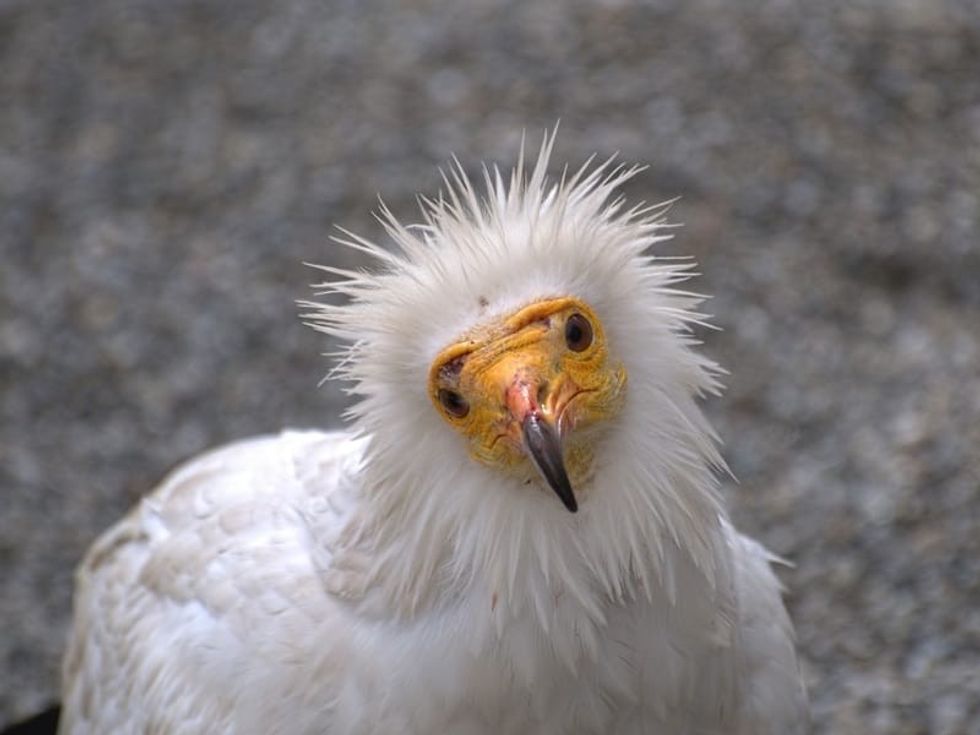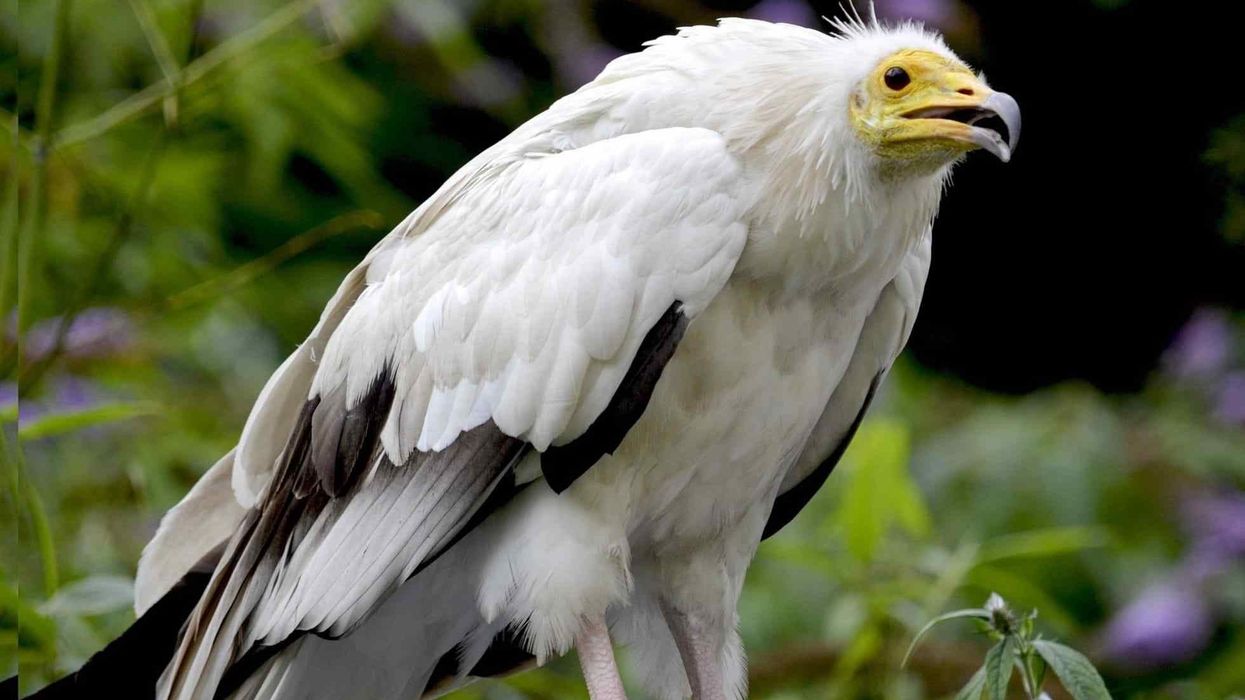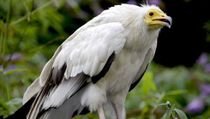Fun Egyptian Vulture Facts For Kids

Content
- What type of animal is an Egyptian vulture?
- What class of animal does an Egyptian vulture belong to?
- How many Egyptian vultures are there in the world?
- Where does an Egyptian vulture live?
- What is an Egyptian vulture's habitat?
- Who do Egyptian vultures live with?
- How long does an Egyptian vulture live?
- How do they reproduce?
- What is their conservation status?
- What do Egyptian vultures look like?
- How cute are they?
- How do they communicate?
- How big is an Egyptian vulture?
- How fast can an Egyptian vulture fly?
- How much does an Egyptian vulture weigh?
- What are the male and female names of the species?
- What would you call a baby Egyptian vulture?
- What do they eat?
- Are they dangerous?
- Would they make a good pet?
- Did you know...
- What is another name for an Egyptian vulture?
- What is unique about Egyptian vultures?
In ancient Egypt, these birds used to symbolize the Goddess Isis, but unfortunately, these beautiful birds are now endangered due to heavy hunting and habitat loss. These diurnal birds are actually very clever, going as far as using tools to get food.
This is probably a reason why they were called the Pharao's chicken at one time. They are found throughout Egypt and North Africa along with some other parts of the world. Read on to learn more interesting facts about these birds!
If you like reading this article, check out our other bird articles with these common murre facts and mountain quail facts.
Egyptian Vulture Interesting Facts
What type of animal is an Egyptian vulture?
Egyptian vultures are a type of old-world vultures, native to the regions of India, North Africa, and throughout the Iberian Peninsula. These vultures mostly feed on dead animals, but they have been also noticed to eat birds, small animals, reptiles, and in some cases also eggs of birds.
What class of animal does an Egyptian vulture belong to?
Egyptian vultures are birds of prey, and like all other members of this species, they have keen eyesight that helps them in locating and hunting their prey. They usually live a long life in captivity as well as in the wild.
Their lifespan in captivity can be as long as 37 years, while they are known to live for about 21 years in the wild.
How many Egyptian vultures are there in the world?
According to the IUCN red list, the number of mature adults of this vulture species is thought to be somewhere around 12000-38000 individuals. Their numbers are constantly decreasing due to the loss of their natural habitat because of agricultural as well as aquacultural purposes.
Another major reason for their decreasing population could be the heavy hunting of this scavenger species for various recreational purposes.
Where does an Egyptian vulture live?
The Egyptian vulture prefers to live in high elevated trees of arid plains, as it helps them when taking a flight. They have also been noticed to inhabit some places near human residential areas because they provide nourishment to these old-world vultures.
They are found in Spain in Southern Europe, North and South Africa, and in some parts of Asia. Unfortunately, their population is constantly decreasing in these regions due to heavy hunting and habitat loss.
What is an Egyptian vulture's habitat?
They often nest in rock ledges or trees near arid plains, but they often migrate during the breeding season to a different nesting site where they lay eggs and raise the offsprings until they are of age enough to hunt for themselves.
Who do Egyptian vultures live with?
The birds of its vulture species can live in groups in a wide territory range. Although, mostly they have been known to live with their mates or as a family group. We bet that it will be a delight to see groups of the Egyptian vulture in flight!
How long does an Egyptian vulture live?
Like most scavenger species, these vultures live a long life. They are known to live for about 21 years in the wild, but some have been recorded to live as long as 37 years in captivity. Their feeding habits include a diet of carcasses as well as small mammals, reptiles, birds, and even bird eggs.
How do they reproduce?
Egyptian vultures are the type of birds that mate for life. Males are known for displays of swooping towards females to woo them.
Egyptian vultures are known to migrate during the breeding season between their regular habitat and the nesting site.
They build a huge nest with fur and torn rags to lay eggs. Egyptian vultures are known to breed only once a year, and the mating season can vary slightly with birds of different geographical regions.
The egg-laying is generally known to happen between the months of March and May. The eggs take about 39-45 days to hatch and during this time the female is noticed to incubate the eggs alone for some time.
Two eggs are usually laid per clutch, but as there is quite a time gap between the time the eggs are laid and the time they are hatched, one of the offspring is usually more stable than the other.
The parents are known to share the responsibility of their offsprings and are known for defending and feeding their offspring. The breeding pairs often go back to the same nesting range often and are known for even using the same best time and again.
What is their conservation status?
These old-world vultures are listed as Endangered species in the IUCN red list. The constant growth of agriculture as well as heavy hunting where their distribution is some of the major reasons for their constantly decreasing population.
The growth of renewable energy and railroads and other utility services turn out to be other major factors for the endangered tag on the conservation list on these birds.
Egyptian Vulture Fun Facts
What do Egyptian vultures look like?
An Egyptian vulture is quite beautiful in its appearance with its back and neck colored white, and black flight feathers. The adult plumage on these vultures also consists of a band-like formation of feathers around their neck and face, which is primarily featherless.
This is possibly why they are also called the 'Pharaoh's chicken'.
The faces of these scavenger birds turn more of an orangeish shade from their regular yellow as the breeding season nears. They have a large bill that is curved at the tip and it gets narrower as it gets closer to the beak portion.
They sometimes carry food like a big egg, or meat pieces from carcasses, in their beaks to feed their offspring.
Vultures that have not yet reached adult age are brown in color. The range length of an adult Egyptian vulture is somewhere between 22.8-27.5 in (58-70 cm).
Very little sexual dimorphism is noticed among the male and female populations of these endangered vulture species. Females are normally a bit heavier than males.
Unfortunately, their population is decreasing due to habitat loss and hunting in places where their distribution is thick, such as Spain in Southern Europe, Africa, India.
Some conservation groups, however, are thankfully working to increase their populations and lift the tag of the endangered status on this vulture population. Read on to learn more facts about the Egyptian vulture subspecies, the Egyptian vulture bill, the Egyptian vulture weight, the Egyptian vulture skeleton, the Egyptian vulture wings and more.

How cute are they?
The Egyptian vulture looks more ferocious than cute with their exotic plumage as they mature into adult age.
Their flight feathers are black in color and the featherless face can range from yellow to orange.
The baby Egyptian vulture does not learn to take flight until about a month after they are fledged, and even then, they are mostly known for taking a flight around the nest with their parents as a family group. Their face takes on more of a reddish tinge when the breeding season nears.
The beauty of the Egyptian vulture is probably one of the reasons why heavy hunting has pushed their populations to be endangered even in places Egyptian vulture distribution is thick, such as Spain in Southern Europe, South Africa, India, and in some other parts of Asia.
Thankfully, there are some conservation groups that are working very hard to keep their populations stable around the world.
How do they communicate?
This vulture species mostly communicates through vocalizations and body language. They have a keen eyesight that they use to locate food.
Instead of looking for food they sometimes find other birds or vultures circling around a specific area, and then wait on the branches if there are trees around. After that, they proceed to feed the carcasses as a group.
One interesting fact about the Egyptian vulture is they keep going back to the same breeding range if not the same nest time and again throughout their long life.
How big is an Egyptian vulture?
Their body length is about 22.8-27.5 in (57.9-69.8 cm) of an Egyptian vulture, wingspan ranges from 18-22 in (45.7-55.9 cm). Strangely, their wingspan is about the same length as a domestic polecat's whole body.
It will be a delight to see the Egyptian vulture in flight with their exotic plumage in their natural habitats in places like South Africa or Southern Europe, and so on.
How fast can an Egyptian vulture fly?
Egyptian vultures are known to fly at a speed of about 34.2 mph (5.5 kph). They are also known to travel for up to 80 m (262 ft.) per day to locate food.
The Egyptian vulture is known to prefer open arid areas to hunt, and they often locate other scavengers and follow them for a meal. Yes, they are very clever which is possibly why there is an Egyptian vulture symbol in hieroglyphs as the ancient Egyptian vulture was worshipped as a symbol of the goddess Isis.
How much does an Egyptian vulture weigh?
An adult Egyptian vulture weighs about 3.5-4.8 lb (1.6-2.2 kg). There is very little sexual dimorphism noticed among this vulture species.
Females have been observed to be a little heavier than males. They generally lay two eggs, one egg of which is usually noticed to be more developed than the other as there is quite a time gap between the egg-laying and hatching process.
A strange fact is that each clutch of this vulture constitutes almost 9% of the bodyweight of the mother vulture. This is much higher than other vulture species.
What are the male and female names of the species?
Like all other species of vultures, the male and female counterparts of Egyptian vultures do not have sex-specific names. Males are just called male Egyptian vultures and a female is just called a female Egyptian vulture.
Neophron percnopterus is their common scientific name. Egyptian vultures tend to mate for life, and the breeding pairs tend to come back to the same nesting range during the breeding season. The parents also share the responsibility for their young, be that feeding or defending their territory.
What would you call a baby Egyptian vulture?
Babies of Egyptian vultures are known as nestlings. Usually, two eggs are laid, out of which one baby vulture is normally more developed than the other.
They are dependent on their parents for feeding and keeping them safe for 3-4 months before they learn to hunt for themselves. The parents are known to carry food for their young in the bill.
After the young or immature birds are fledged they are noticed to fly around the breeding areas with their parents as a family group. It can be about a month after they are fledged before they take flight for the first time.
What do they eat?
Egyptian vultures are known mostly to have carrion or dead animals for their diet, but they have also been observed to eat small animals, reptiles, amphibians, bird eggs, and sometimes even nestlings. They are known for caring for their offspring until they can hunt and gather food for themselves.
during this time adult birds bring food for their children in their beaks.
As they feed on bird eggs, and sometimes even nestlings, large, ground-living birds are threatened by them. Egyptian vultures are a particularly intelligent species of birds.
If the egg of a bird is big, they use rocks and pebbles to crack it open before they eat it.
Strangely, Egyptian vultures also get nourishment from the excrements of large animals as well as humans, it even helps them to keep their facial color stable. The babies of Egyptian vultures however are fed a diet of small animals as they provide calcium to strengthen their bones.
Are they dangerous?
Most hunting birds pose a threat to people if they are agitated enough, and the Egyptian vulture is no different. Although, these birds that were once worshipped, face more danger from humans than any threat they seem to possess.
Due to heavy hunting and habitat loss, they are on the verge of extinction, which can cause serious ecosystem problems for humans.
So, the only way to deal with Egyptian vulture threats is to keep their population thriving. A particularly aggressive species of vulture is the black vulture which gets easily agitated when feeding.
Would they make a good pet?
Scavenger birds do not make good pets, even though some have been known to be tamed throughout the centuries. Especially as they are an endangered species, it is better not to keep them as pets.
Did you know...
They were worshipped in ancient Egypt as a symbol of the Goddess Isis.
This species is diurnal and hence, active during the day.
What is another name for an Egyptian vulture?
Egyptian vultures were worshipped in ancient Egypt, which is possibly why one of the names they are known by is 'Pharaoh's chicken'.
What is unique about Egyptian vultures?
They are one of the very few bird species that are clever enough to use a tool to get food. They use pebbles to crack open eggs that are particularly hard-shelled.
Here at Kidadl, we have carefully created lots of interesting family-friendly animal facts for everyone to discover! For more relatable content, check out these king vulture facts and Cooper's hawk facts pages.
You can even occupy yourself at home by coloring in one of our free printable Egyptian vulture coloring pages.
We Want Your Photos!
More for You
See All
Bachelor of Arts specializing in Journalism and Mass Communication, Postgraduate Diploma in Sports Management

Moumita DuttaBachelor of Arts specializing in Journalism and Mass Communication, Postgraduate Diploma in Sports Management
A content writer and editor with a passion for sports, Moumita has honed her skills in producing compelling match reports and stories about sporting heroes. She holds a degree in Journalism and Mass Communication from the Indian Institute of Social Welfare and Business Management, Calcutta University, alongside a postgraduate diploma in Sports Management.
Bachelor of Arts specializing in Economics

Gowri RaoBachelor of Arts specializing in Economics
With a bachelor's degree in Economics from Krea University, Gowri is a highly skilled data analyst and an expert in regression and causation modeling. Her interests in economic trends, finance, and investment research complement her professional expertise. In addition to her professional pursuits, Gowri enjoys swimming, running, and playing the drums, and she is also a talented tutor.
Disclaimer
1) Kidadl is independent and to make our service free to you the reader we are supported by advertising. We hope you love our recommendations for products and services! What we suggest is selected independently by the Kidadl team. If you purchase using the Buy Now button we may earn a small commission. This does not influence our choices. Prices are correct and items are available at the time the article was published but we cannot guarantee that on the time of reading. Please note that Kidadl is a participant in the Amazon Services LLC Associates Program, an affiliate advertising program designed to provide a means for sites to earn advertising fees by advertising and linking to Amazon. We also link to other websites, but are not responsible for their content.
2) At Kidadl, we strive to recommend the very best activities and events. We will always aim to give you accurate information at the date of publication - however, information does change, so it’s important you do your own research, double-check and make the decision that is right for your family. We recognise that not all activities and ideas are appropriate for all children and families or in all circumstances. Our recommended activities are based on age but these are a guide. We recommend that these ideas are used as inspiration, that ideas are undertaken with appropriate adult supervision, and that each adult uses their own discretion and knowledge of their children to consider the safety and suitability. Kidadl cannot accept liability for the execution of these ideas, and parental supervision is advised at all times, as safety is paramount. Anyone using the information provided by Kidadl does so at their own risk and we can not accept liability if things go wrong.
3) Because we are an educational resource, we have quotes and facts about a range of historical and modern figures. We do not endorse the actions of or rhetoric of all the people included in these collections, but we think they are important for growing minds to learn about under the guidance of parents or guardians.







